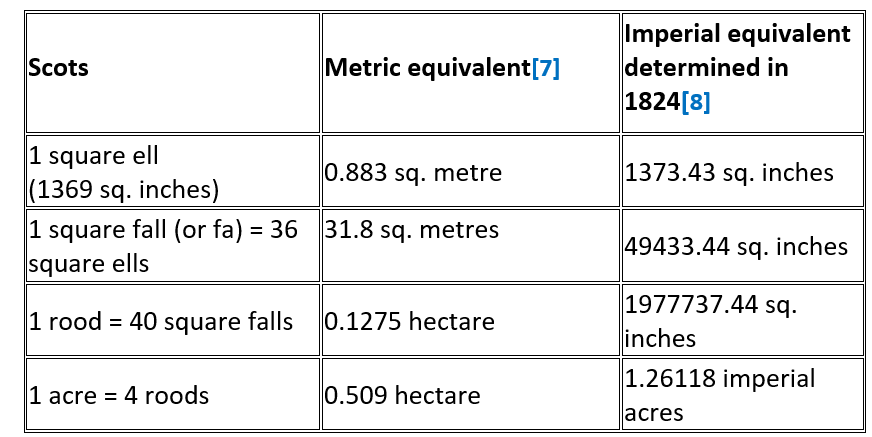Weights & measures – distance & area
Weights and Measures: Scottish Distance and Area
Distance
The main units of linear measure were the foot and the mile. The foot was, traditionally, the length of a man’s foot and the inch was a twelfth part of a foot (from the Latin word uncia, meaning ‘a twelfth’, which is also the root of the word ‘ounce’). The ell (from the Latin ulna, meaning ‘forearm’) was traditionally the distance from the elbow or shoulder to the wrist or fingertips. A fall (from the Old Norse fale, meaning a ‘pole’ or ‘perch’) was the equivalent of the English measure, the ‘pole’. The furlong was traditionally the distance an ox could pull a plough before needing a rest (literally a ‘furrow long’). The mile (from the Roman mille passus or passuum) was based on the Roman linear measure 1000 paces.
The inch, according to Connor and Simpson, was identical to the English inch.[1] However, in 1824 the parliamentary authorities determined that the imperial inch was slightly larger than the existing inch.[2] The system of measurements, based on the ell of 37 inches, resulted in the Scots mile being equivalent to 1.12 English miles. There was also a longer Scots mile of 1500 paces which was equivalent to 1.42 English miles.[3] Scots used a foot of 12 inches and also a specialist glass foot, or glazier’s foot, used in the glass trade only, which was 8.88 inches long.[4]
1 yard = 36 inches
1 imperial mile = 1760 yards
Area
The main units of area were the rood and acre. The rood (from the word rod, meaning a measuring rod) was the equivalent of 40 square falls or a rectangular piece of land of 40 falls length by 4 falls width. The acre corresponded to the size of a ploughed field (probably from the Anglo-Saxon word acer or aecer, meaning a ‘field’).
The Scottish units of area were abolished in 1824 and replaced by imperial measures based on the yard.
1 imperial acre = 4840 square yards = 0.405 hectares
Further information on Scots measurements can be found in the Dictionaries of the Scots Language <https://dsl.ac.uk/ > [accessed 24 April 2024].
Compilers: SCAN contributors (2000). Editor: Elspeth Reid (2021)
Related Knowledge Base Entries
Weights and measures: origins of weights and measures in Scotland
Weights and Measures: Scottish Dry Capacity
Weights and Measures: Scottish Liquid Capacity
Weights and Measures: Scottish Weight
Trading Standards & Consumer Protection
Bibliography
Buchanan, George, Tables for Converting the Weights and Measures Hitherto in Use in Great Britain […] also Abstracts of the Jury Verdicts throughout Scotland in Regard to the Weights and Measures of Each County (Edinburgh, 1829)
Connor, R. D. and A. D. C. Simpson, Weights and Measures in Scotland: A European Perspective, ed. by A. D. Morrison-Low (NMSE, 2004)
References
[1] R. D. Connor and A. D. C. Simpson, Weights and Measures in Scotland: A European Perspective, ed. by A. D. Morrison-Low (NMSE, 2004), p. xiv, 750.
[2] Weights and Measures Act 1824 (5 Geo. IV c.74); George Buchanan, Tables for Converting the Weights and Measures Hitherto in Use in Great Britain […] also Abstracts of the Jury Verdicts throughout Scotland in Regard to the Weights and Measures of Each County (Edinburgh 1829), pp.28-29.
[3] Connor & Simpson, Weights and Measures in Scotland, pp. 96, 755.
[4] Connor & Simpson, Weights and Measures in Scotland, p. 88.
[5] Metric measurements calculated from those given in Connor & Simpson, Weights and Measures in Scotland, p. 755.
[6] Imperial inches taken from Buchanan, Tables for Converting the Weights and Measures p. 28, yard measurements calculated from Buchanan, p. 28.
[7] Metric measurements calculated from those given in Connor & Simpson, Weights and Measures in Scotland, p. 755.
[8] Imperial measurements taken from Buchanan Tables for Converting the Weights and Measures pp. 30, 40 (Measures of Extent Table III)



